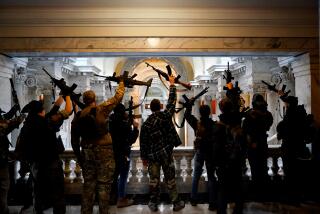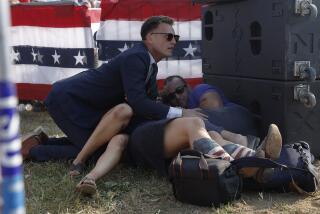One of the ‘Gun Guys’
Dan Baum has an agenda. He wants you to listen to the guys who like guns — particularly if you are an NPR-listening, Whole Foods-shopping progressive. That’s how you could describe Baum, a former New Yorker staff writer and lefty down the line — except for his love of rifles, revolvers and the rest.
“From the urban, educated effete liberal Democrat side of my world I’m hearing all of this disparaging of ‘gun guys,’ how stupid and awful they are,” he says, speaking by phone from his home in Colorado. “These are conversations that for years I’ve endured as kind of like a closeted gay man listening to people talking about ‘fags’ and ‘homos’ — I would just stay quiet.”
FOR THE RECORD:
Update 3:45 p.m. Feb. 14, 2013: An earlier version of this article said that the “AR” in “AR-15” stands for “Assault Rifle.” Although it is commonly understood in that regard, the initials derive from the company ArmaLite, which first manufactured the AR-15 in the 1950s.
Baum is bringing his weaponry out of the closet in “Gun Guys: A Road Trip,” which Knopf is publishing March 5. In the book, he travels the country to meet some of America’s 70 million to 80 million gun owners, talking to collectors and hunters, people concerned with self-defense and those who take pleasure in the skill of shooting. He gets a permit to carry a concealed weapon and explains the frisson, part power and part threat, of passing through daily life secretly armed.
His book arrives at an opportune moment. After highly publicized incidents of gun violence like the killing of six adults and 20 children at Sandy Hook Elementary in December, gun control again becomes a topic of heated public debate.
“Both camps have driven each other so far apart that we can’t talk about this stuff rationally, because it’s tribal,” says Baum.
Yet he tends to lay the blame at the feet of his liberal cohorts. “The anti-gun tribe thinks it can weaken the gun tribe by attacking the totem. By banning it, by making it invisible, by paring it down as much as it can.”
With one foot in each camp, Baum sees himself as uniquely positioned to explain gun-lovers to gun-haters. “I just want people, when they think about these questions, to have listened to rational, calm, intelligent voices that they might not otherwise have encountered,” he says. It is an eclectic lineup: a Texas pig hunter, a wealthy collector, a Hollywood gun prop house and the man who founded Jews for the Preservation of Firearms Ownership.
Baum’s book about New Orleans after Katrina, “Nine Lives,” also wove together the voices of the people he interviewed; he draws out his subjects, despite his own strong opinions.While his interviewees in “Gun Guys” provide an interesting narrative, the most enlightening element of the book may be its clear explanation of some of the basics of contemporary gun ownership.
Many gun-control advocates suggest banning assault rifles; Baum points out that the most popular gun in America today is the Bushmaster AR-15: It’s modular, highly customizable, lightweight and easy to shoot well.
“It’s the only gun anybody wants,” Baum says. And what is an AR-15? An assault rifle.
“Far from being some kind of bizarre anomaly of the gun business, it is the absolute heart of the gun business: the most popular gun and the most profitable gun,” Baum says. “So if you’re wondering why even Barack Obama has backed off from the assault-rifle ban, that’s why.”
If the question “Who needs an assault rifle?” seems entirely rational to his liberal friends, to most American gun owners it sounds like a direct attack. For Angelenos, the equivalent might be “Who needs a car?” If technically we don’t need one, the question seems like a threat to our core way of living.
“Gun guys are not like camera buffs; they’re not like fly fishermen, not like car buffs. It’s deep, it’s really deep,” he explains. “I was really trying to figure out why these things move us, why they are so important to us.”
Baum’s own love affair with guns began at age 5; at summer camp he discovered he had a natural aptitude for target shooting. He was attracted to the physicality of guns and charmed by the James Bond mythology he associated with them.
But in his liberal suburb, the late ‘60s brought a schism between the weapons and his world. “I was against the [Vietnam] war too, and aspired to the hippie aesthetic as much as any other sixth-grader,” he writes. “But that didn’t keep me from liking guns. To me, they were separate.”
This separation between guns and violence is an essential part of Baum’s world view. As he details the way guns make him feel, one thing becomes clear: He finds power in carrying but not using a weapon. “Out on the street, I felt vigilant, aloof from petty animosities,” he writes. He eschews verbal engagement when secretly armed — and he says it’s not just him.
“Gun guys derive a tremendous amount of self-esteem from being able to live alongside these incredibly dangerous things without anybody getting hurt,” he says.
He imagines the thought process this way: “I can live with guns, I can travel around with guns, I can take them to the range and shoot guns, I can teach children to shoot guns, I can hunt with guns, I can carry a gun, and nobody gets hurt. Because I am competent and careful and enough of a sheepdog to manage this incredibly lethal thing.”
The juxtaposition of the lethal potential of guns with the feeling of power they impart is apparent in the tragic story of Brandon Franklin, a promising young man Baum had met in New Orleans while working on “Nine Lives.”A few years later, when Baum was working on this gun book, Franklin was murdered during a dispute with his ex-girlfriend’s new boyfriend. Brandon had not been carrying a gun; the other man had.
“The unknowable that really tortured me,” Baum writes, “was this: if Brandon had been formally inducted into the sheepdog cadre and had had a legal gun concealed on his person.... Might the gun have saved his life without ever being drawn?”
The inverse, of course, is the other side of the debate: Wouldn’t his life have been saved if his murderer hadn’t carried one at all?
More to Read
Sign up for our Book Club newsletter
Get the latest news, events and more from the Los Angeles Times Book Club, and help us get L.A. reading and talking.
You may occasionally receive promotional content from the Los Angeles Times.







